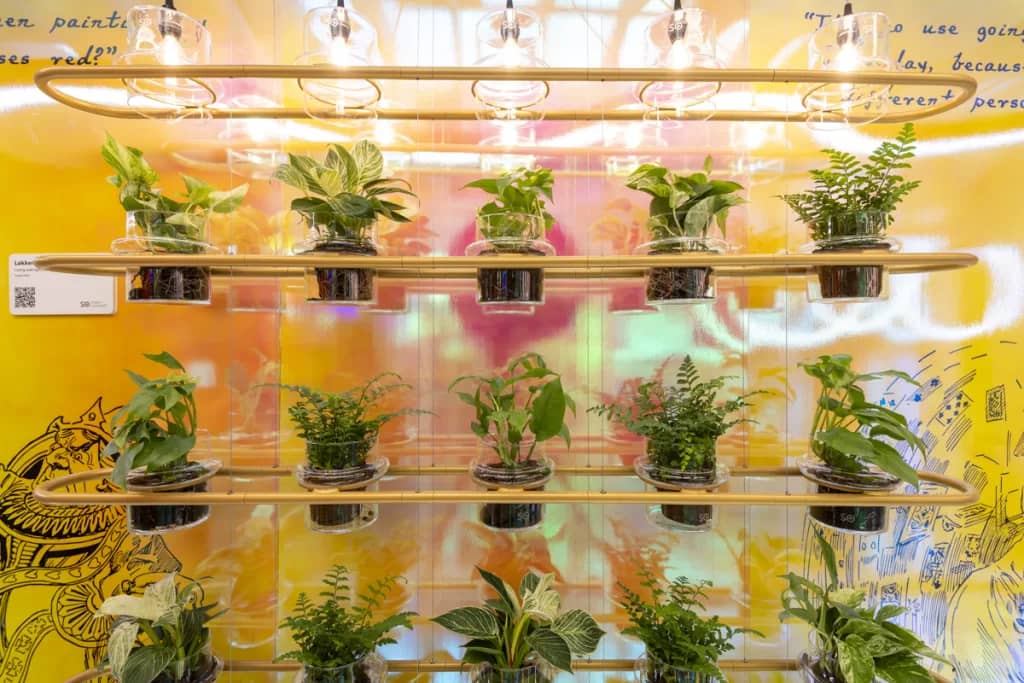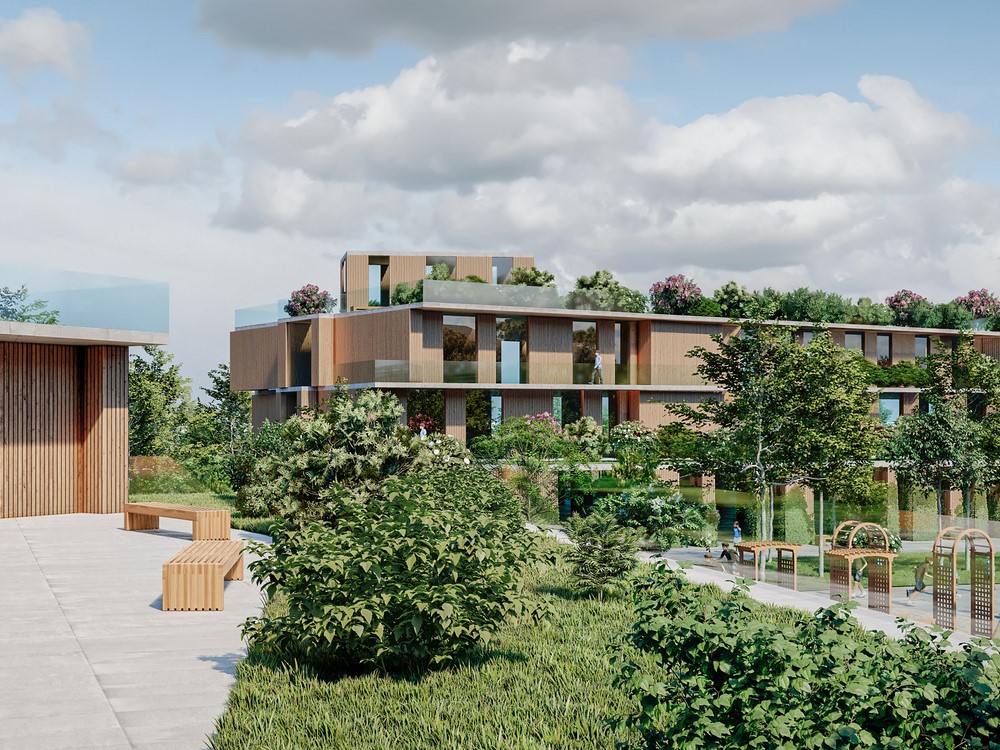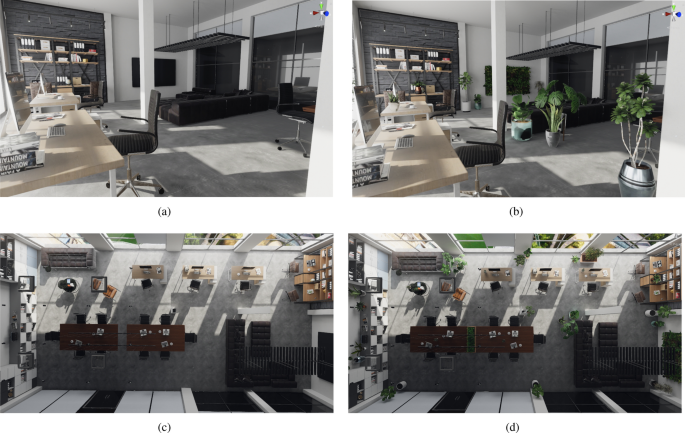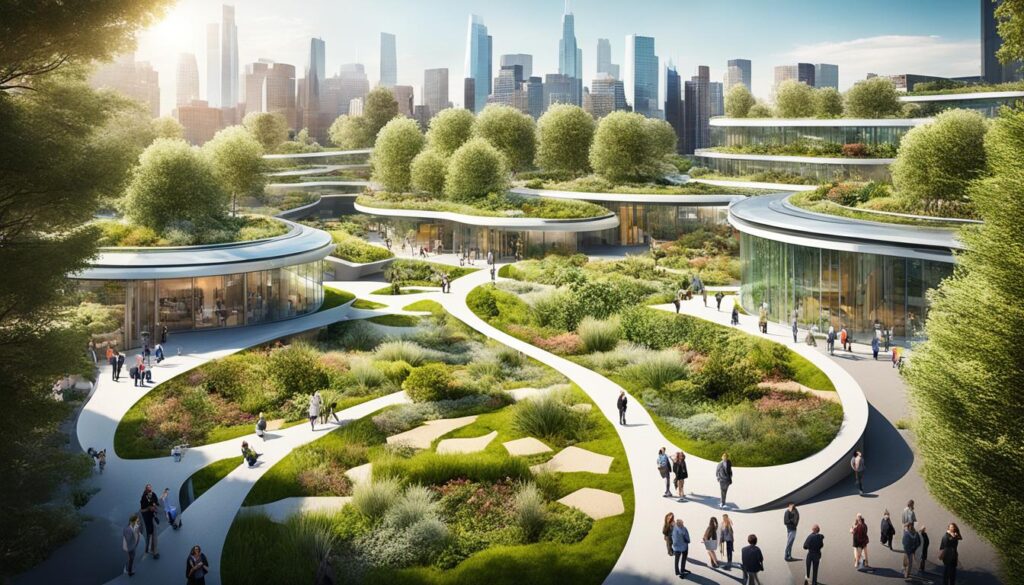Cutting-Edge Materials for Biophilic Design.
Biophilic design integrates the built environment with nature, cultivating a profound connection between individuals and their surroundings. As urban spaces increasingly become detached from the natural world, the significance of biophilic design becomes ever more critical.
This article examines the fundamental elements that characterize biophilic design, including nature-inspired materials, living walls, and water features. It also investigates the numerous benefits associated with this approach, such as enhanced mental well-being and increased productivity, while showcasing innovative materials that facilitate these designs.
This exploration invites readers to appreciate a realm in which nature and architecture coexist harmoniously.
What is Biophilic Design?
.jpg_00.jpeg)
Biophilic design represents a transformative approach to architecture and design that aims to establish a connection between individuals and nature through the integration of natural elements, patterns, and experiences within the built environment.
This innovative methodology underscores the significance of nature in our daily lives, acknowledging that our health and well-being are profoundly influenced by our surroundings.
By incorporating biophilic elements such as natural light, indoor plants, and organic textures, biophilic design seeks to create harmonious spaces that foster comfort, productivity, and emotional well-being.
In the context of increasing urbanization and environmental challenges, the principles of biophilic design provide a sustainable solution to enhance both our living and working environments.
Why is Biophilic Design Important?
Biophilic design is increasingly acknowledged as a vital component of architecture and urban planning, significantly contributing to health and well-being by fostering a connection between individuals and the natural environment.
By incorporating natural elements such as daylight, indoor vegetation, and water features, biophilic design creates restorative environments that promote mental health, reduce stress, and enhance overall quality of life. This approach not only supports individual wellness but also aligns with broader objectives of environmental sustainability, encouraging the use of eco-friendly materials and energy-efficient design practices.
This design philosophy has the potential to transform community spaces by fostering inclusive environments that encourage social interaction and collaboration among diverse groups. Through the integration of green roofs, community gardens, and natural gathering areas, biophilic design cultivates a sense of belonging while enhancing ecological impact through increased biodiversity.
The psychological benefits of biophilic design are extensive, as individuals often experience improved mood, enhanced cognitive function, and better physical health when surrounded by nature-infused environments. Ultimately, the implementation of biophilic principles results in sustainable living environments that not only enhance personal well-being but also promote resilient communities, underscoring the interconnected relationship between human health and environmental stewardship.
What are the Key Elements of Biophilic Design?
The key elements of biophilic design consist of a range of features that collectively enhance the human experience within the built environment by drawing inspiration from nature. This approach aims to create spaces that are both functional and aesthetically pleasing.
Essential elements include the use of nature-inspired materials, which incorporate organic textures and locally sourced materials, as well as the provision of ample natural light and views that connect occupants with the outdoors.
The integration of living walls, greenery, and water features not only enhances biodiversity but also contributes to sensory design, fostering immersive experiences that promote emotional connections with nature.
1. Nature-Inspired Materials
Nature-inspired materials are essential to biophilic design, as they harness the beauty and functionality of natural elements while promoting sustainability within the built environment.
By employing eco-friendly materials such as recycled substances, natural wood, clay, and stone textures, architects and designers can create spaces that evoke a sense of harmony and connection to nature. These materials not only enhance aesthetic appeal but also contribute to improved air quality and overall resilience, fostering a healthier indoor environment for occupants.
Emphasizing the principles of material science, these components can significantly reduce the environmental impact associated with construction processes, thereby aligning with contemporary sustainability practices.
Biophilic design principles utilize environmental psychology to enhance cognitive function and emotional well-being, resulting in improved productivity and reduced stress for inhabitants.
Incorporating these natural elements cultivates a sense of tranquility and belonging, effectively bridging the gap between indoor and outdoor spaces. As the demand for eco-conscious design continues to rise, the focus on such innovative materials is reshaping the architectural landscape and paving the way for a more sustainable future.
2. Natural Light and Views
Natural light and views are critical components of biophilic design, as they establish a direct connection between indoor environments and the surrounding landscape, significantly enhancing the user experience. By optimizing daylighting through large windows and strategically positioned openings, designers can create bright and inviting spaces that increase productivity and well-being while reducing reliance on artificial lighting.
Access to views of nature not only improves the quality of light but also cultivates a sense of tranquility and connection to the external environment.
This integration fosters visual harmony, which is instrumental in alleviating stress and anxiety, ultimately contributing to improved mental health among occupants. The psychological benefits are further complemented by physiological advantages, such as the ability of natural light to regulate circadian rhythms, thereby enhancing sleep quality and overall health.
Moreover, incorporating energy-efficient design practices ensures that these spaces remain sustainable, reducing energy costs while still delivering the health benefits associated with natural light. Collectively, embracing these essential elements in design not only enhances aesthetic appeal but also significantly supports the well-being of individuals inhabiting these environments.
3. Living Walls and Greenery
Living walls and greenery are essential components of biophilic design, offering both aesthetic enhancement and substantial environmental benefits, including improved air quality and increased biodiversity within urban environments.
By integrating indoor plants and vertical gardens, designers can create multifunctional spaces that foster thriving indoor ecosystems, thereby promoting a heightened sense of well-being among occupants. These green features facilitate a deeper connection with nature, encouraging lifestyles that recognize the importance of the natural world.
The incorporation of plants and greenery has significantly transformed urban landscapes, creating serene oases that enhance sensory experiences for urban residents. These elements not only soften the harsh lines of architecture but also provide habitats for various species, thereby enriching local biodiversity.
Furthermore, these vibrant installations can substantially mitigate the effects of urban heat islands, ensuring cooler environments during hot summer months. The sensory design aspects—comprising the visual appeal, sounds, and aromas associated with greenery—serve to alleviate urban stress, rendering these spaces not only visually attractive but also restorative.
In summary, living walls and landscaping play a crucial role in fostering healthier ecosystems and creating vibrant community spaces.
4. Water Features
.jpg_01.jpeg)
Water features represent a compelling element of biophilic design, providing not only aesthetic appeal but also contributing to acoustic comfort and the establishment of healing environments within the built context.
The sound of flowing water can evoke tranquility and relaxation, thereby enhancing the overall user experience and fostering an emotional connection to nature. By incorporating water features into both indoor and outdoor spaces, architects can create immersive experiences that encourage occupants to engage with their surroundings and appreciate the inherent beauty of nature.
These elements can manifest in various forms, including fountains, ponds, or even simple tabletop water displays, each offering distinct sensory benefits.
The gentle ripples of a pond, for example, can engage visual senses while reflecting light, creating dynamic visuals that evolve throughout the day. Simultaneously, the soothing sounds of cascading water can effectively mask urban noise, providing individuals with an escape from the chaos of daily life.
Such integration fosters a deeper emotional connection with the environment, reinforcing the concept that nature and constructed spaces can coexist in harmony, ultimately promoting well-being and a sense of calm among users.
What are the Benefits of Biophilic Design?
The advantages of biophilic design are comprehensive, affecting not only individual health and well-being but also promoting environmental sustainability and enhancing communal spaces.
Research indicates that the integration of biophilic elements into interior environments can result in improved mental health, increased productivity, and heightened creativity among occupants. Additionally, implementing sustainable design and green architecture practices plays a significant role in reducing ecological impact, thereby establishing biophilic design as a critical component of contemporary architectural strategies focused on creating a healthier planet.
1. Improved Mental Well-being
One of the most significant advantages of biophilic design is its profound impact on mental well-being, as spaces that incorporate natural elements and sustainable materials promote a sense of tranquility and connection to the environment.
Research has demonstrated that exposure to nature-inspired design can alleviate stress and anxiety, ultimately contributing to improved overall mental health. By creating restorative environments that prioritize emotional connection with nature, biophilic design encourages occupants to flourish both mentally and physically, illustrating the principles of wellness design.
Evidence indicates that when individuals engage with natural elements—such as indoor plants, water features, and natural lighting—they experience a reduction in cortisol levels, which are frequently elevated during periods of stress. Environments rich in biophilic design not only enhance mood but also improve concentration and cognitive function, thus rendering them ideal for workspaces and educational settings.
These findings underscore the essential role that nature plays in our emotional and psychological well-being, highlighting the benefits of integrating biophilic principles into everyday spaces as a means to achieve healthier, more balanced lives, and reducing our ecological footprint.
This inherent connection between nature and emotional health emphasizes the necessity of fostering environments that nurture rather than impede our mental state, showcasing the importance of human-centric design.
2. Increased Productivity and Creativity
Incorporating biophilic design elements into work environments has been shown to significantly enhance productivity and creativity among employees. By integrating features inspired by nature, such as natural light, greenery, and organic textures, workplaces become more inviting and stimulate innovative thinking. This improved user experience not only boosts employee morale but also contributes to better performance and job satisfaction, making biophilic design a vital strategy for contemporary organizations. The incorporation of nature-inspired patterns and organic shapes can further enhance the workspace environment.
Research has substantiated that these design principles can lead to a notable increase in cognitive function and imaginative problem-solving abilities. For example, studies have indicated that workplaces incorporating indoor plants and providing access to natural vistas can enhance concentration and reduce stress levels—both of which are essential in fostering a thriving work culture.
The aesthetic appeal of such environments also positively influences employees’ emotional well-being, facilitating a deeper connection to their surroundings. Adopting biophilic elements reflects a commitment to enhancing functional beauty and signifies an organization’s dedication to prioritizing employee health and creativity, thereby driving overall success and improving design sustainability.
3. Better Air Quality
Improved air quality is one of the significant benefits of biophilic design, as the integration of indoor plants and natural ventilation systems effectively purifies the air and enhances the overall indoor environment. Research indicates that spaces designed with biophilic principles can reduce airborne pollutants and allergens, thereby significantly contributing to the health benefits of occupants and improving thermal comfort.
By prioritizing air quality through the use of eco-friendly materials and natural elements, biophilic design fosters healthier living and working conditions for all, emphasizing the importance of environmental psychology.
These design strategies not only enhance air quality but also cultivate a sense of connection to nature, which is essential in environmental psychology. Incorporating a diverse array of indoor plants can serve as natural air filters, absorbing harmful toxins and increasing oxygen levels, while simultaneously promoting tranquility and reducing stress, thus enhancing sensory experience.
Implementing natural ventilation techniques, such as operable windows and vents, further enhances airflow and temperature regulation, rendering indoor spaces not only more breathable but also more comfortable. This practice significantly improves the overall ventilation systems in buildings.
By combining these elements, individuals may experience heightened cognitive function and overall well-being, thereby illustrating the profound impact that biophilic design has on health and productivity, aligning with the principles of health and safety.
4. Reduced Stress and Anxiety
Biophilic design possesses a significant capacity to alleviate stress and anxiety levels among occupants, thereby creating healing environments that promote tranquility and overall well-being, reflecting the principles of nature therapy.
The incorporation of natural elements, such as water features, greenery, and natural light, not only enhances the aesthetic quality of a space but also cultivates an atmosphere conducive to relaxation and mindfulness. Research indicates that environments designed according to biophilic principles can substantially reduce cortisol levels, the hormone linked to stress, resulting in a more balanced emotional state and improved emotional well-being.
This design approach leverages the inherent human connection to nature, often eliciting a profound emotional response that can further augment mental wellness. Psychological studies emphasize the importance of integrating biophilic elements into various settings, demonstrating that individuals tend to report feelings of calmness and improved focus in spaces enriched with plants and natural materials, thus enhancing visual comfort.
Furthermore, anecdotal evidence supports these findings, as many individuals note that spending time in nature or in nature-inspired interiors helps them recharge both mentally and emotionally, showcasing the benefits of nature integration.
By prioritizing wellness architecture that embodies these principles, individuals can cultivate a deeper emotional connection to their surroundings, transforming everyday spaces into sanctuaries of healing and serenity, reflecting the principles of emotional design.
What are the Cutting-Edge Materials Used in Biophilic Design?
.jpg_10.jpeg)
Cutting-edge materials are integral to biophilic design, as they promote sustainable architecture and strengthen the connection between occupants and the natural environment. This approach emphasizes the use of material innovation to achieve these goals.
Advances in material science have resulted in the creation of eco-friendly materials that not only minimize environmental impact but also enhance health and well-being within built environments, promoting the principles of sustainable practices.
By incorporating these innovative materials, architects and designers can develop spaces that are both functional and harmoniously aligned with the natural world, effectively embodying the principles of biophilic design, and contributing to overall design resilience.
1. Biodegradable Materials
Biodegradable materials are emerging as a key component of sustainable architecture, providing environmentally responsible alternatives that are consistent with the principles of biophilic design, thereby supporting zero-waste design.
By incorporating materials that decompose naturally over time, architects can effectively minimize waste and contribute to a circular economy while still creating aesthetically pleasing and functional spaces. These eco-friendly materials not only mitigate ecological impact but also enhance the visual appeal of buildings, fostering a deeper connection between occupants and nature, and promoting health benefits.
The integration of biodegradable materials, such as natural wood, hemp, and mycelium, promotes resource efficiency by utilizing renewable resources that regenerate rapidly. For instance, the use of bamboo for flooring or insulation derived from recycled paper not only ensures a reduced carbon footprint but also enriches the interior environment, enhancing the aesthetics of nature.
When buildings constructed with these materials reach the end of their life cycle, they can naturally decompose, thereby significantly reducing landfill waste and supporting the development of a more sustainable urban landscape, contributing to urban greening.
Ultimately, the adoption of biodegradable materials in design not only advocates for ecological wellness but also encourages a transition towards a more responsible and harmonious coexistence with the environment, reflecting principles of ecological design.
2. Recycled Materials
The utilization of recycled materials in biophilic design represents a significant commitment to sustainable architecture and resource efficiency, as it effectively reduces waste and minimizes the need for new materials, promoting adaptive reuse.
By incorporating recycled materials into their designs, architects are able to create unique and aesthetically pleasing spaces that address environmental concerns concurrently. These materials not only contribute to a reduced ecological footprint but also foster innovative design solutions that honor the principles of reuse, supporting multifunctional materials.
The integration of reclaimed wood, recycled metals, and upcycled textiles facilitates the development of spaces that resonate with nature and evoke a sense of tranquility. This approach enhances the visual experience while fostering a deeper connection to the environment, encouraging occupants to engage more harmoniously with their surroundings, reflecting the principles of landscape architecture.
Numerous projects, ranging from eco-friendly office buildings to residential homes, have successfully adopted these practices, demonstrating how material innovation can improve both form and function, ultimately paving the way for a more sustainable future, supporting community engagement.
3. Sustainable Wood
Sustainable wood is an essential material in biophilic design, as it represents both environmental responsibility and aesthetic appeal, facilitating the creation of spaces that resonate with nature. It also enhances the principles of craftsmanship and artisanal techniques.
Sourced from responsibly managed forests, sustainable wood options offer a beautiful, organic texture that enhances the sensory experience within a given space. By prioritizing sustainable wood, designers can reduce their ecological impact while fostering a deeper connection to the natural world, emphasizing the importance of material durability.
The utilization of this natural material not only supports resource efficiency by minimizing waste but also encourages eco-friendly practices such as using renewable resources and biodegradable materials that benefit both the environment and the economy.
Its inherent warmth and diverse grain patterns allow for versatile applications, ranging from flooring to furniture, making it a compelling choice for individuals seeking to harmonize their surroundings with natural elements and organic shapes.
Integrating sustainable wood into biophilic designs can evoke feelings of tranquility and relaxation, transforming an ordinary environment into a sanctuary that promotes emotional well-being, creativity, and productivity.
4. Natural Stone and Sustainable Materials
Natural stone is recognized as a timeless and elegant material within biophilic design, offering both aesthetic appeal, material durability, and craftsmanship while establishing a strong connection to the earth. By integrating natural stone into their designs, architects can create spaces that reflect the beauty of the natural environment, thereby enhancing the overall sensory experience.
This material not only presents unique textures and colors but also positively impacts the environment by utilizing locally sourced resources and supporting sustainable practices.
The application of natural stone establishes a harmonious relationship between the built environment and nature, fostering a sense of tranquility and well-being. Its inherent beauty and variety, ranging from rough-hewn finishes to smooth polished surfaces, can evoke a tactile connection that promotes mindfulness, visual comfort, and appreciation for the surroundings.
Utilizing natural stone in construction contributes to reducing the carbon footprint, as it is often more energy-efficient than synthetic alternatives. In the design of spaces such as gardens, walkways, or interior features, the strategic application of this material can harmonize aesthetics with functionality, creating environments that not only appeal visually but also support sustainable living practices and green architecture.
5. Living Materials and Nature Integration
Living materials represent an innovative and compelling aspect of biophilic design, effectively actualizing the integration of nature through the utilization of biologically active components in building materials. These materials, which may encompass living organisms such as moss, fungi, and various plant species, not only enhance the aesthetic value of spaces but also contribute to ecological design, adaptive reuse practices, and promoting biodiversity.
The incorporation of living materials into architectural projects has the potential to significantly reduce ecological footprints by fostering biodiversity, encouraging natural processes, and enhancing indoor air quality.
For example, living walls and roofs provide insulation, enhance air quality, and support urban wildlife, thereby cultivating vibrant ecosystems and promoting urban greening within urban environments.
These materials are dynamic; they evolve and adapt over time, presenting a unique ecological narrative that responds to varying environmental conditions. By harmonizing form, function, and nature, designers can leverage the transformative potential of living materials, ultimately redefining the relationship between human habitats and the natural world while promoting sustainable design principles and adaptive reuse.
Frequently Asked Questions
.jpg_11.jpeg)
What are “Cutting-Edge Materials” in Biophilic Design?
“Cutting-Edge Materials” refer to innovative and advanced materials that are used in biophilic design to mimic the natural world and create a healthier and more sustainable environment. These materials include smart materials and multifunctional materials that enhance the overall design sustainability of the space.
How do Cutting-Edge Materials benefit Biophilic Design?
Cutting-Edge Materials bring the natural world into built environments, providing a more biophilic and sustainable design approach that improves human well-being, emotional design, and connection to nature.
What are some examples of Cutting-Edge Materials used in Biophilic Design?
Some examples of Cutting-Edge Materials for Biophilic Design include living walls, green architecture, natural ventilation systems, and sustainable building materials like bamboo, cork, and reclaimed wood. These materials help achieve a harmonious indoor-outdoor connection and a strong sense of nature integration.
Are Cutting-Edge Materials expensive to incorporate into Biophilic Design?
While some Cutting-Edge Materials may be more expensive, there are also affordable options that can still achieve the same biophilic design goals. It ultimately depends on the specific material and design project, including considerations of material durability and resource efficiency.
What are the environmental benefits of using Cutting-Edge Materials in Biophilic Design?
Cutting-Edge Materials often have a lower carbon footprint and can contribute to a more sustainable and eco-friendly design. They can also improve indoor air quality, light quality, and reduce energy consumption, ultimately promoting wellness design.
How can I incorporate Cutting-Edge Materials into my Biophilic Design project?
You can incorporate Cutting-Edge Materials into your biophilic design project by researching and selecting materials that align with your design goals and budget, and working with a knowledgeable and experienced design team.

I’m Bruno, an architect with a deep passion for Biophilic Design in Urban Architecture. Throughout my career, I’ve focused on integrating natural elements into urban planning, and I created this site to share my insights and foster a deeper understanding of how biophilic principles can significantly enhance urban living. Dedicated to sustainable development, I continually explore innovative design solutions that promote both environmental and human well-being in city landscapes.














Publicar comentário